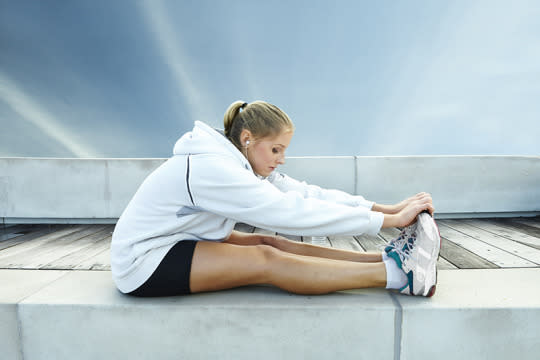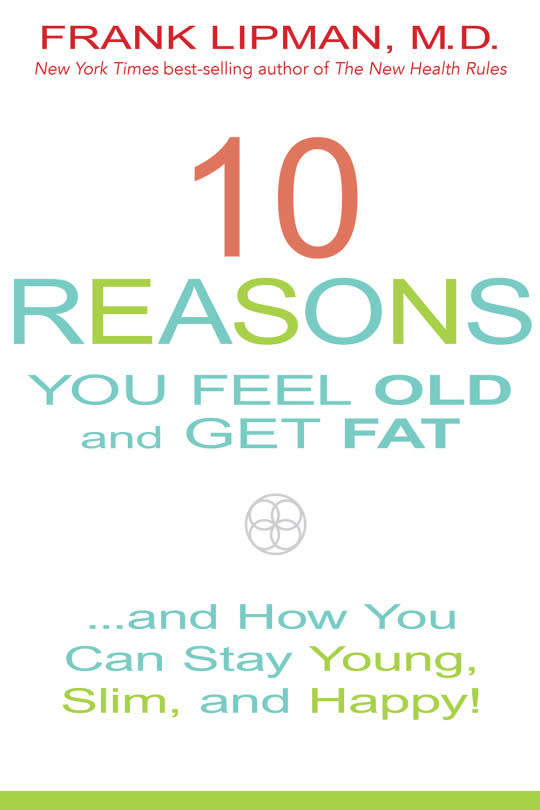The Surprisingly Simple Way to Anti-Age Your Whole Body

Building strength is only one way to stay young. (Photo: Getty Images)
Dr. Frank Lipman is a pioneer and internationally recognized expert in the fields of integrative and functional medicine. He is the founder and director of Eleven Eleven Wellness Center in New York City. Below is an excerpt from his latest book, 10 Reasons You Feel Old and Get Fat.
When you think about exercise, what first comes to mind?
Most people, I think, start by thinking about the muscles. But what about the parts of our body that lie between the muscles, connecting muscle to muscle, muscle to bone, and bone to bone? The tendons, ligaments, and particularly the fascia are of crucial importance to health and well-being — and yet they are often ignored, even by physicians, trainers, and exercise gurus.
What’s Between Your Muscles?
Fascia (pronounced FASH-ya): bands of soft tissue that are fused with your bones, muscles, tendons, nerves, blood vessels, and organs. Superficial fascia lie close to the surface — just below your skin. Deep fascia lie farther down. You need soft, supple fascia to allow your muscles to move easily, but as you age — and especially if you have had injuries, haven’t been active, or haven’t stretched properly — your fascia tend to stiffen up. When your fascia aren’t doing their job, you can develop adhesions: tight places where tissues that should be separated by fascia have fused. Injury can create adhesions. So can inflammation. And so can chronic stress. As a result, you feel stiff, inflexible, off-balance, and sometimes in pain.
Tendons: tough cords that attach your muscles to your bones. Your muscles communicate with your brain via your nervous system, so if you want to move, you move your muscles — which then rely on your tendons to transmit power to your bones. Tendons can easily become inflamed, producing the painful condition known as tendonitis. The diet, supplement, and lifestyle suggestions described throughout this book can help heal and prevent tendonitis by reducing inflammation. Exercise also has key anti-inflammatory benefits.
Ligaments: tough tissue that connects bones directly to other bones. By holding your bones in place, they support your joints. Healthy ligaments are crucial for preventing sprains, strains, aches, and pains. To prevent straining the ligaments, it’s essential to keep the muscles, tendons, and fascia in shape.
As a physician, I know how important these connectors — particularly the fascia — can be, which is one [reason] I actually think that flexibility is as important as strength, especially as we age. Don’t get me wrong: Strength is important. You want to have arms strong enough to lift a suitcase and legs strong enough to carry your body. But you also want to feel supple, flexible, and open to new experiences, because that sense of flexibility and openness is one of our best defenses against feeling old.
Related: Banish Stress and Tone Your Whole Body With a Foam Roller
Think about what happens when you feel stressed or upset. If you’re like most people, you tense up, usually in a characteristic place; you tighten that part of your body over and over and over again. Perhaps when you’d like to snap back at your boss or get into a familiar argument with your spouse, you restrain yourself— and tense your jaw. Perhaps when a family member starts a familiar complaint or round of teasing, you brace yourself— and hunch your shoulders. Perhaps when you think about the long round of errands and obligations that awaits you before you’ve even gotten out of bed, you try to rouse yourself— and tighten your back. Repeat those movements hundreds and thousands of times over the years, without ever doing yoga, massage, acupuncture, or even gentle stretching to loosen and open the affected areas, and by the time you’re in your 40s, 50s, or 60s, you might easily have developed a permanent ache, pain, or stiffness.
These insults to your fascia are exacerbated if you have a job that requires you to sit for long hours at a desk. Your soft tissue realigns to accommodate this habitual posture, sitting slumped and round shouldered. Your hamstrings — the muscles running down the backs of your legs — become shortened, which rounds your lumbar spine (your lower back), pulling your pelvis forward. Your shoulders roll forward too, and creep slowly up toward your ears. As you try to focus your eyes, your chin pokes forward, tightening the muscles and fascia at the base of your skull.
By the time you reach middle age, what’s the result? You’ve got a chronically stiff neck, or perhaps a perpetually sore back. Your joints, worn out from the pressure, begin to ache. Your muscles don’t respond easily and vigorously — they stiffen as you try to bound up out of your chair, or fight you as you try to sink gracefully back down.
As with the other conditions we have considered, stiffness, achiness, and loss of mobility are not the inevitable result of getting older. They result from a way of life, a sedentary life without the movement your body craves. Or, if you have indeed exercised vigorously your entire life, stiffness, aches, and pains are your body’s way of telling you that perhaps you neglected to stretch — perhaps you focused on the strength of your muscles, ignoring their flexibility and the suppleness of your fascia.
What Creates Tension, Adhesions, Aches, and Pains?
Keeping a muscle in a shortened position for a long time: sleeping in a bad position, sitting at a desk, sitting on a plane
Repetitive movement: typing, cradling a telephone, running with poor form
Lack of stretching
Unhealed or partially healed old injuries
Adhesions from surgery
Inflammation
Air conditioning or cold air
Viral illness
If stiffness and achiness are, in some sense, things we’ve done to ourselves, the good news is that we can undo them. By choosing to stretch and nurture our fascia, we can regain the youthful openness we might have thought was lost forever.
Related: Sculpt a Ballet Body — Without Ever Touching a Barre
So many of my patients have greatly improved from these simple ways of freeing up the fascia and releasing muscular tension. Once you become aware of how your body holds tension, you can easily learn one of several techniques to release that tension. A habitual practice of releasing tension — through breathing, stretching, and/or yoga — will make a world of difference to your mind, body, and spirit. Your physical flexibility will nurture your mental flexibility so you won’t feel so “stiff-necked” and “braced” but will greet the world with more suppleness and grace. Instead of feeling old and stiff, you’ll feel vigorous, youthful, and open. That is the gift of movement.
How Stretching Keeps You From Feeling Old
Less soreness because of the decrease in muscular tension: no more back pain, neck pain, or headaches
Increased flexibility: Stretching counters the gradual constriction you can suffer from overuse or underuse of different areas of your body
Fewer injuries: strains, sprains, tendonitis, muscle spasms
Faster recovery time from injuries
Greater body awareness
Mental and physical relaxation
Better performance at skilled tasks, including sports
Better function in the nervous system: less anxiety, depression, brain fog, and fewer memory problems
Improved circulation: healthier heart and cardiovascular system
EXCERPTED FROM ‘10 REASONS YOU FEEL OLD AND GET FAT’ BY DR. FRANK LIPMAN, PUBLISHED BY HAY HOUSE (FEBRUARY 2016) AND AVAILABLE IN BOOKSTORES AND ONLINE AT WWW.HAYHOUSE.COM.

Read This Next: This Body-Boosting Secret Wards Off Colds, Puffy Eyes, and Excess Weight Gain
